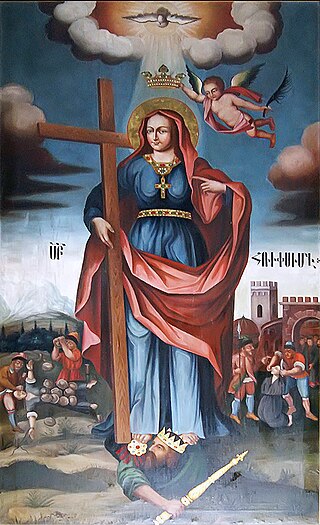Related Research Articles

Canonization is the declaration of a deceased person as an officially recognized saint, specifically, the official act of a Christian communion declaring a person worthy of public veneration and entering their name in the canon catalogue of saints, or authorized list of that communion's recognized saints.

A martyr is someone who suffers persecution and death for advocating, renouncing, or refusing to renounce or advocate, a religious belief or other cause as demanded by an external party.
Acacius is a masculine given name which may refer to:

The Forty Martyrs of England and Wales or Cuthbert Mayne and Thirty-Nine Companion Martyrs are a group of Catholic, lay and religious, men and women, executed between 1535 and 1679 for treason and related offences under various laws enacted by Parliament during the English Reformation. The individuals listed range from Carthusian monks who in 1535 declined to accept Henry VIII's Act of Supremacy, to seminary priests who were caught up in the alleged Popish Plot against Charles II in 1679. Many were sentenced to death at show trials, or with no trial at all.

The Forty Martyrs of Sebaste or the Holy Forty were a group of Roman soldiers in the Legio XII Fulminata whose martyrdom in the year 320 AD for the Christian faith is recounted in traditional martyrologies.
This is a calendar of saints list for the Armenian Apostolic Church.
Nicopolis was a Roman colony in Lesser Armenia founded by Pompey in 63 BC after conquering the Kingdom of Pontus in the Third Mithridatic War. It became part of the Roman province of Armenia Prima. Today, the city of Koyulhisar in northeastern Turkey occupies the site.

Hripsime, also called Rhipsime, Ripsime, Ripsima, Ripsimia, Ripsimus, Arbsima or Arsema was a martyr of Roman origin; she and her companions in martyrdom are venerated as some of the first Christian martyrs of Armenia.

Church of the Holy Mother of God, is an Armenian Apostolic church located in the Sulaimaniyeh district of Aleppo, Syria. The church is active since its consecration on May 1 May 1983, by then-Catholicos of the Holy See of Cilicia Karekin II.

The Forty Martyrs Armenian Cathedral of Aleppo, Syria, is a 15th-century Armenian Apostolic church located in the old Christian quarter of Jdeydeh. It is significant among the Armenian churches for being one of the oldest active churches in the Armenian diaspora and the city of Aleppo. It is a three-nave basilica church with no dome. Its bell tower of 1912, is considered to be one of the unique samples of the baroque architecture in Aleppo.

The Kldisubani St. George Church or Qarapi Saint Gevorg church is an 18th-century church at the foot of the Narikala citadel in Old Tbilisi, Georgia. The church is single-naved and was built in 1753. The Georgian Orthodox Church was built on the site of an ancient Georgian church which was built during the reign of St. King Vakhtang I of Iberia. The church was reconstructed with the help of Armenian merchant Petros Zohrabian and his wife Lolita and the restoration held by them in 1735, what makes the church one of the most important examples of Georgian-Armenian friendship and cooperation.
Saint John or St. John usually refers to John the Baptist, but also, sometimes, to John the Apostle.

Church of the Dormition of Our Lady is a Greek Orthodox church in Jdeydeh quarter of Aleppo, Syria. The church belongs the Greek Orthodox Prelacy, the Diocese of Aleppo. It was built during the first half of the 15th century and is active up to now.

Armenian Diocese of Beroea, is one of the oldest dioceses of the Armenian Apostolic Church outside the historic Armenian territories, covering the Syrian city of Aleppo and the governorates of Deir ez-Zor, Idlib, Latakia and Raqqa. It is known as Beroea, being named after one of the ancient names of Aleppo; when the city was renamed Beroea (Βέροια) in 301 BC by Seleucus Nicator until the Arab conquest of Syria and Aleppo in 637 AD. The seat of the bishop is the Forty Martyrs Cathedral of Aleppo. It is under the jurisdiction of the Holy See of Cilicia of the Armenian Church.

The Shoghakat Church or Shoghagat Church is an Armenian Apostolic church in Tabriz, East Azerbaijan Province, Iran completed in 1940.
Saint Sarkis Church of New Julfa,, is an Armenian Apostolic church in the Armenian quarter New Julfa of Isfahan, Iran.
References
- ↑ "Forty Armenian Martyrs". Archived from the original on 2012-11-02. Retrieved 2012-03-08.